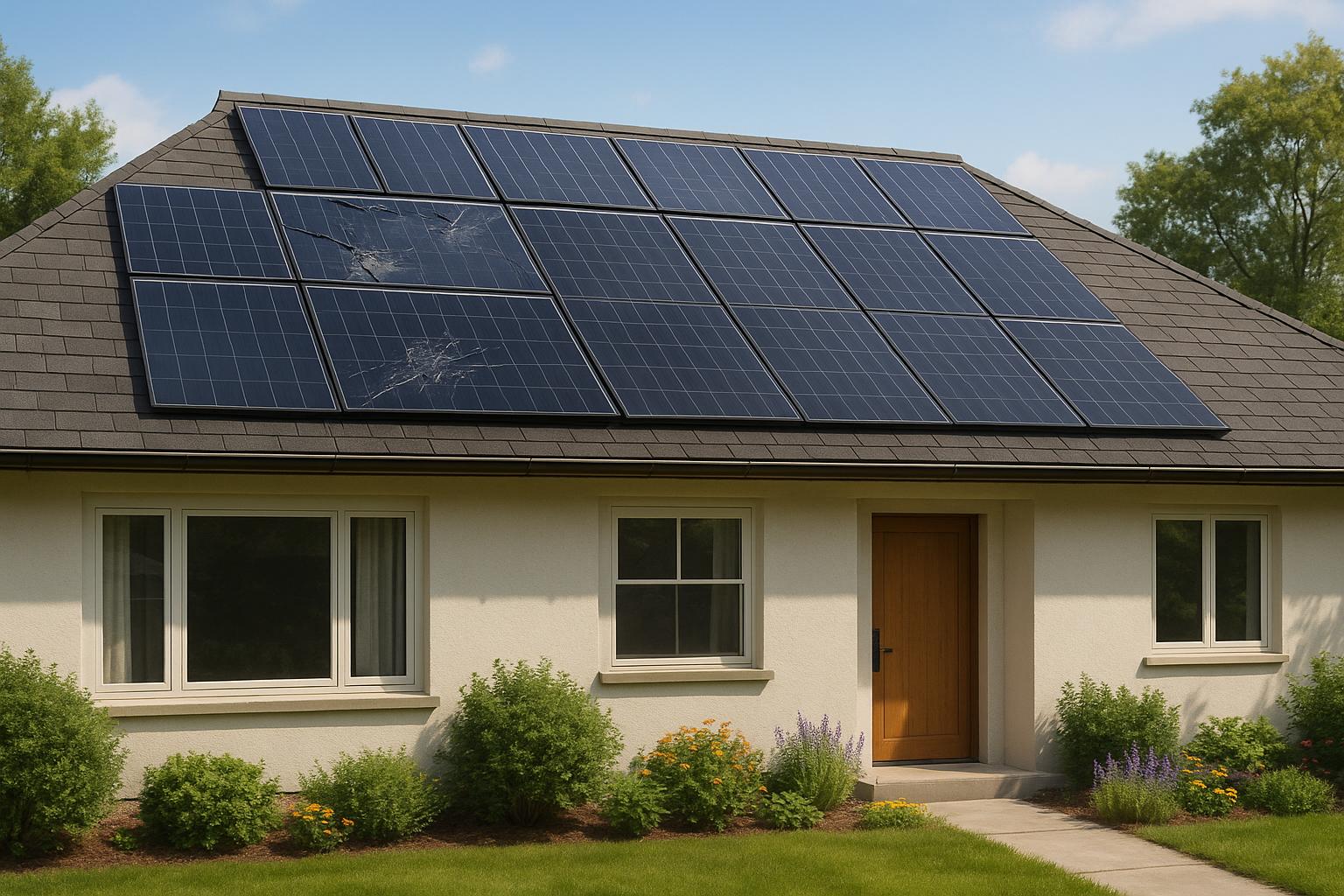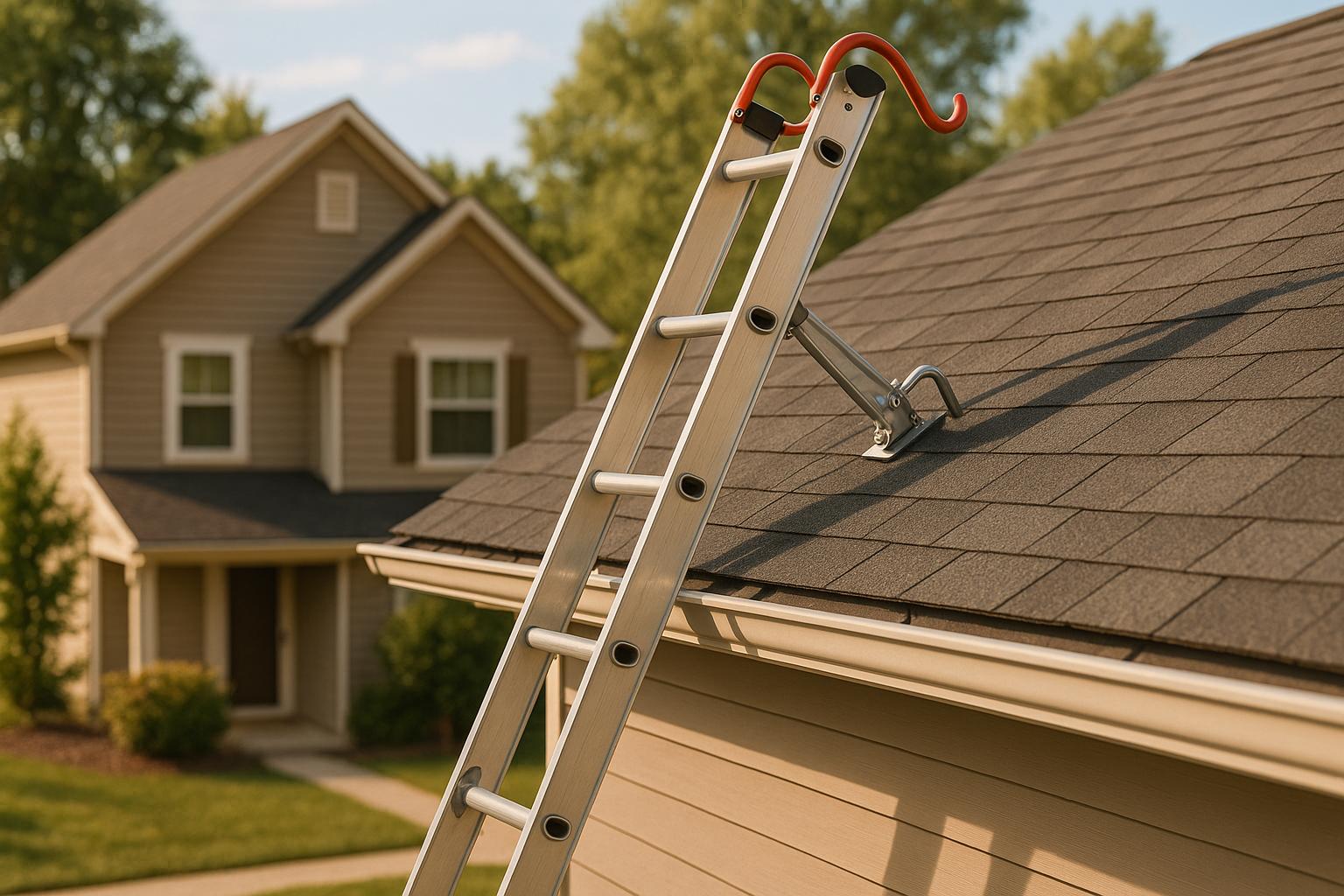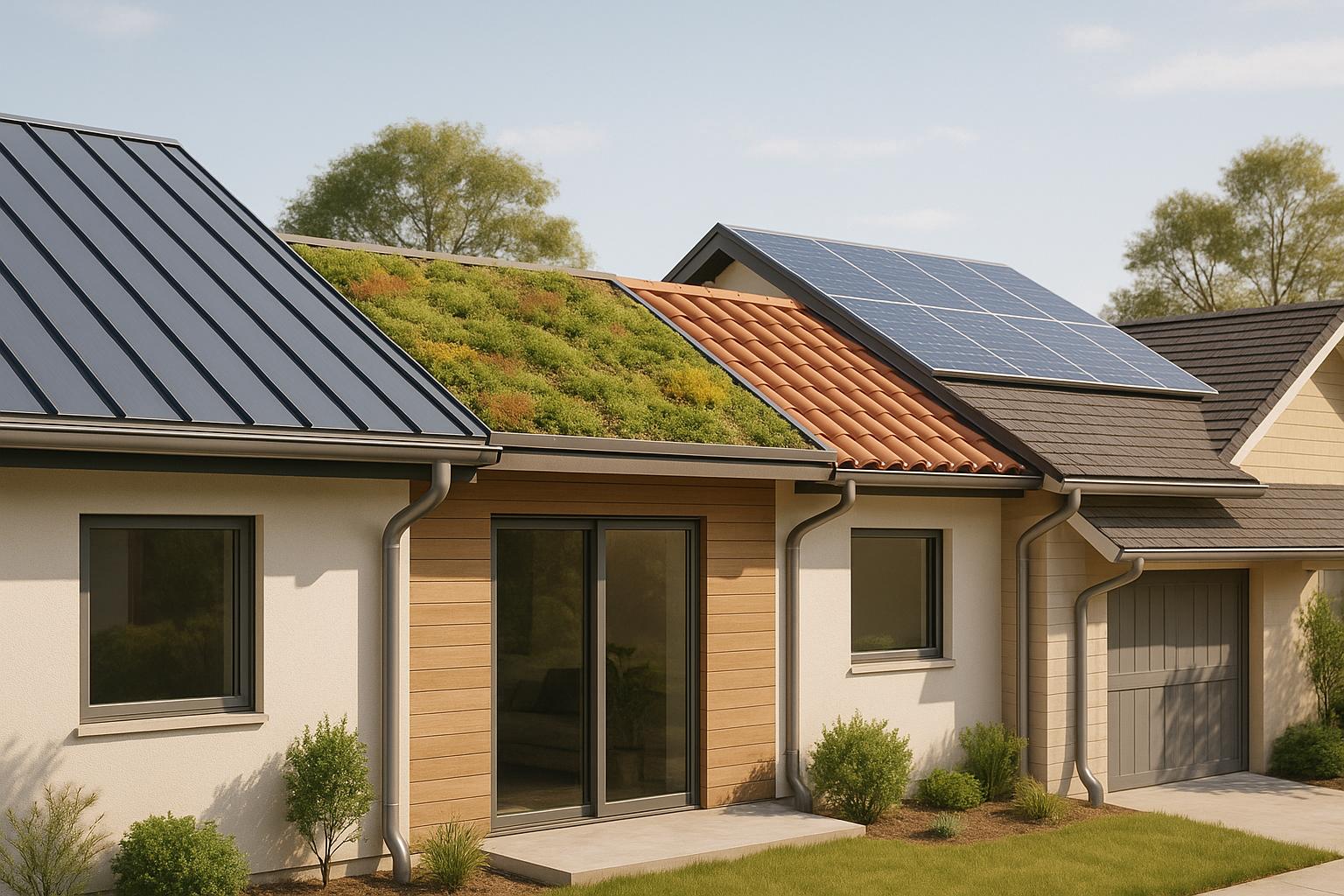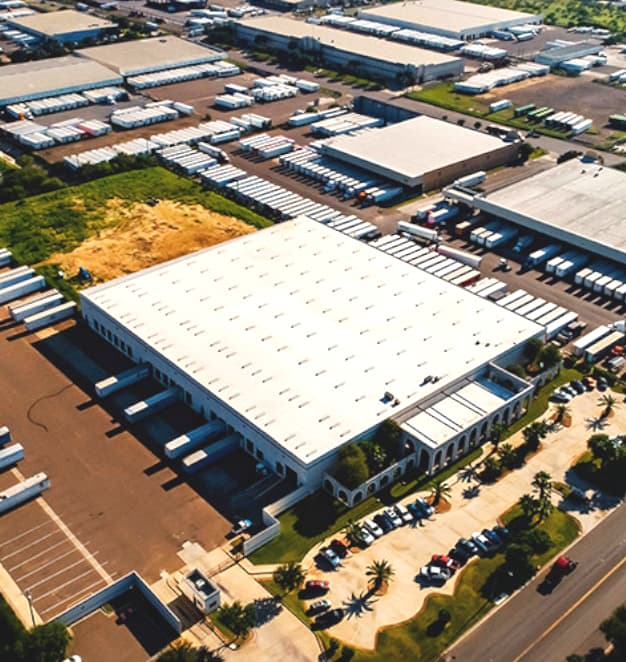Want to save on cooling costs and boost your roof’s lifespan? Energy-efficient roofing in Los Angeles can cut cooling bills by up to 25%, reduce urban heat, and even qualify you for rebates and tax credits. Here’s what you need to know:
- Material Costs: Options like asphalt shingles ($7–$11/sq ft), metal roofing ($12.50–$20.50/sq ft), and clay tiles ($15–$25/sq ft) vary in price and energy efficiency.
- Labor Expenses: Labor can make up 50–70% of the total cost, ranging from $2–$20/sq ft depending on complexity.
- Permits & Codes: Expect to pay $250–$500 for permits, with strict requirements under California’s Title 24 energy code.
- Rebates & Incentives: Programs like LADWP rebates ($0.20–$0.60/sq ft) and federal tax credits (up to $1,200/year) can offset costs.
- Financing Options: PACE and other programs offer no-money-down financing for eligible homeowners.
| Material | Cost (per sq ft) | Lifespan | Energy Efficiency |
|---|---|---|---|
| Asphalt Shingles | $7–$11 | 20–30 years | Moderate |
| Metal Roofing | $12.50–$20.50 | 35–70 years | High |
| Clay Tiles | $15–$25 | 50–100 years | Low |
| Synthetic Shingles | $8–$14 | 30–50 years | Moderate |
Quick Tip: Work with experienced contractors to ensure compliance with local codes and maximize rebates. Investing in energy-efficient roofing not only saves money but also helps the environment.
Metal Roof vs Shingles Roof Costs. Is A Metal Roof Worth It? [Price For Metal Roof Vs Asphalt + ROI]
Main Cost Factors for Energy-Efficient Roof Installation
When planning for energy-efficient roofing in Los Angeles, the total cost boils down to three main factors: materials, labor, and permits. Each of these components varies depending on the specific choices and requirements of your property.
Material Costs and Options
Los Angeles homeowners have a range of roofing materials to choose from, each with different price points and performance levels.
- Asphalt shingles: These are the most affordable option, priced between $7.00 and $11.00 per square foot, including installation. While they offer moderate energy efficiency, their lifespan is typically 20–30 years.
- Metal roofing: Known for its durability and energy-saving benefits, metal roofing is available in two forms:
- Steel or aluminum standing seam panels: $12.50 to $20.50 per square foot.
- Metal shingles or shakes: $10.00 to $16.50 per square foot. Metal roofs have a longer lifespan, lasting 35 to 70 years, with some materials like copper and zinc exceeding 100 years.
- Clay tiles: These are a premium choice, costing $15.00 to $25.00 per square foot, while concrete tiles provide a more budget-friendly alternative at $10.00 to $18.00 per square foot. Both options can last 50–100 years with proper care.
- Synthetic roofing materials: Offering a balance between cost and performance, these materials range from $8.00 to $14.00 per square foot and provide better energy efficiency than standard asphalt.
Energy-efficient roofing materials can significantly lower cooling costs. For example, specialized surfaces can remain up to 60°F cooler than traditional black roofs during the summer. Reflective coatings or white membranes further enhance this effect by deflecting sunlight.
| Roofing Material | Cost per Square Foot | Average Lifespan | Energy Efficiency |
|---|---|---|---|
| Asphalt Shingles | $7.00 – $11.00 | 20–30 years | Moderate |
| Metal Roofing (Steel/Aluminum) | $12.50 – $20.50 | 35–70 years | High |
| Metal Shingles | $10.00 – $16.50 | 35–70 years | High |
| Clay Tiles | $15.00 – $25.00 | 50–100 years | Low |
| Concrete Tiles | $10.00 – $18.00 | 50–100 years | Low |
| Synthetic Shingles | $8.00 – $14.00 | 30–50 years | Moderate |
Labor Costs in Los Angeles
Labor costs in Los Angeles can make up a significant portion of the total roofing expense, often accounting for 50–70% of the project cost.
"Labor costs can account for up to 60% of installation costs, especially if your roof’s complexity includes features like skylights or chimneys."
For basic shingle installations, labor costs typically range from $2.00 to $3.50 per square foot. However, energy-efficient materials often require specialized skills, which can increase labor costs. For instance, metal roof installations demand expertise, with labor costs ranging from $4.00 to $8.00 per square foot.
Complex roof designs, such as those with steep pitches or multiple angles, can further raise labor expenses to $4 to $15 per square foot. If your project involves specialty materials like solar-integrated systems or advanced cool roof coatings, labor costs can climb even higher, reaching $8–20 per square foot.
Additionally, removing an old roof adds $1 to $5 per square foot, and roofers typically charge $30 to $100 per hour for their services. Overall, replacing a roof in Los Angeles can cost anywhere from $8,000 to $30,000, depending on the materials, labor, roof size, and complexity.
Permits and Code Requirements
Roofing projects in Los Angeles require permits, which can range from $250 to $500 for standard projects. For more complex jobs, fees can climb as high as $4,080. Additional costs may include certificates, inspections, and revisions.
California’s Title 24 energy code sets standards for energy-efficient roofing, influencing both material selection and installation methods. These standards are updated every three years, with the next update scheduled for 2025.
Local regulations in Los Angeles often exceed state requirements. For example:
- In the City of Los Angeles, asphalt shingles must meet a Solar Reflectance Index (SRI) value of 20 for all new construction and reroofing projects in both residential and commercial buildings.
- In unincorporated areas of Los Angeles County, asphalt shingles must achieve a 3-year aged solar reflectance value of 0.25 and an initial thermal emittance value of 0.85, or an SRI value of 20.
"Completing a project without a permit could result in major fines or having to tear it down and start over. A reputable contractor can pull the necessary permits for you prior to starting a project." – Caroline Gilbert, Director, Content & Editorial, Angi
Given California’s wildfire risks, fire-resistant roofing materials are increasingly required, often necessitating additional documentation and compliance checks. Reliable contractors typically include permit costs in their quotes and handle the application process, ensuring your project meets all local codes and avoids delays or penalties.
Rebates, Incentives, and Financing Options
When it comes to energy-efficient roofing, the upfront costs can seem daunting. However, rebates, incentives, and financing options can help ease the financial burden, making these upgrades more affordable. In Los Angeles, homeowners have access to a variety of programs, including local utility rebates, federal tax credits, and flexible financing plans. These options not only reduce the initial investment but also contribute to long-term savings by improving energy efficiency.
Local and State Rebates
The Los Angeles Department of Water and Power (LADWP) offers a cool roof rebate program that can significantly offset costs. Homeowners can receive a base rebate of $0.20 per square foot for qualifying cool roofs, with an enhanced rebate of up to $0.60 per square foot for materials meeting a 3-year Solar Reflectance Index (SRI) of 85 or higher. For a 2,000-square-foot roof, this translates to savings between $400 and $1,200. Southern California Edison (SCE) also provides rebates for cool roof coatings, applicable to both residential and commercial properties.
To qualify for LADWP rebates, homeowners must submit the following documents:
- Original proof of purchase, including manufacturer details and model numbers
- A copy of the first page of your LADWP bill
- Roofing permit documentation
- An itemized invoice with details like CRRC Product ID, square footage, slope, and color
- Final approved building permit
Applications must be submitted within 12 months of purchase, and rebates are distributed on a first-come, first-served basis. Additionally, programs like Energy Upgrade California can provide even more savings opportunities.
Federal and Utility Incentives
On a federal level, the Energy Efficient Home Improvement Credit offers a tax credit of 30% on qualified expenses, capped at $1,200 annually. Unlike older programs with lifetime limits, this credit resets every year, meaning homeowners can claim up to $1,200 annually for eligible improvements. Additional credits of up to $2,000 per year are available for specific upgrades like heat pumps and high-efficiency water heaters.
The Inflation Reduction Act (IRA) has expanded these benefits, further encouraging energy-efficient home improvements. For instance, cool roofs can reduce cooling costs by as much as 20%. California’s HEERA (High-Efficiency Electric Home Rebate Act) program offers additional rebates for income-qualified households, providing up to $8,000 for families earning less than 80% of the area median income and up to $4,000 for those earning between 80% and 150%.
"Thousands of dollars are now available for California homeowners to install heat pumps, making your home more energy-efficient and reducing your energy bills by hundreds of dollars each year. With these new rebates made possible by the Biden-Harris administration, Californians can save money and take real climate action." – Governor Gavin Newsom
| Incentive Program | Rebate/Credit Amount | Eligibility Requirements |
|---|---|---|
| LADWP Cool Roof Rebate | $0.20 – $0.60 per sq ft | LADWP customer, approved materials, proper documentation |
| Federal Energy Efficient Home Improvement Credit | Up to $1,200 annually | Primary residence, qualified improvements, existing home |
| HEERA Program | Up to $8,000 | Income-qualified households, specific equipment requirements |
Financing and Long-Term Savings
Even with rebates and tax credits reducing upfront expenses, financing options make energy-efficient roofing projects even more achievable. Programs like PACE (Property Assessed Clean Energy) financing through YGrene offer 100% financing with no money down, no FICO score requirements, and tax-deductible payments. Alternatively, Service Finance provides traditional financing options, such as 12 months same-as-cash or longer-term plans with interest rates ranging from 6.99% to 7.99%. The GoGreen Home Energy Financing program also helps by offering lower rates and extended payback terms for energy-efficient upgrades.
Energy-efficient roofs deliver long-term savings by cutting utility bills by up to 25%, which can amount to $300–$500 annually. For example, increasing a roof’s Solar Reflectance Index from 25 to 40 can lower surface temperatures by over 13°F, translating to a 15–20% reduction in energy costs. Considering that roof replacement costs in California typically range from $20,000 to $30,000, these combined savings make energy-efficient roofing a smart financial decision.
To fully benefit from these programs, it’s essential to work with experienced contractors who understand the rebate and incentive landscape. They can ensure your project meets all the necessary qualifications, helping you maximize savings from the start.
sbb-itb-d1d6490
Energy-Efficient Roofing Materials Comparison
Picking the right energy-efficient roofing material for your Los Angeles home means weighing the pros and cons of different options. Each material has its own strengths and weaknesses, from initial costs to long-term performance. The key is finding a balance between affordability, energy savings, and durability. Here’s a breakdown of some leading materials based on their performance, cost, and lifespan.
Los Angeles homeowners have several energy-efficient choices to explore. Metal roofing is a standout option due to its excellent reflectivity and longevity, lasting 40–70 years while cutting cooling costs by up to 40% in hot climates. Clay and concrete tiles are another solid choice, offering natural insulation and a lifespan of 50–100 years, which pairs well with the Mediterranean-style homes often seen in LA. For maximum energy efficiency, cool roofs with reflective membranes can reduce peak cooling demand by 10–15%.
If you’re working with a tighter budget, asphalt shingles remain a popular choice. However, they typically last only 20–30 years and don’t offer the same level of energy efficiency as premium materials. Synthetic roofing materials strike a middle ground, with a lifespan of 30–50 years, moderate energy efficiency, and a more affordable price point.
Given Los Angeles’ sunny and often hot climate, materials with high solar reflectance perform particularly well. The city’s occasional severe weather also makes impact resistance an important factor. Class 4 impact-resistant shingles, for example, cost 50% to 100% more than standard options but can handle winds up to 130 mph, compared to 110 mph for regular shingles. These shingles often come with 50-year warranties, offering more peace of mind than the 30-year coverage typical of standard products.
Your home’s style and structural capacity should also influence your decision. Heavier materials like clay tiles might require additional structural support, which can increase installation costs. Maintenance is another factor to consider. Metal roofing and synthetic materials usually need little upkeep, while green roofs require regular care and specialized expertise. Asphalt shingles, on the other hand, need periodic inspections and repairs, especially given LA’s intense UV exposure.
To maximize savings, look for materials that qualify for local rebate programs. For instance, LADWP offers cool roof rebates for products that meet specific Solar Reflectance Index standards, potentially saving you $400–$1,200 on a typical residential installation. These programs, combined with federal incentives, can significantly reduce your overall costs.
Once you’ve chosen the best material, proper installation is critical to ensure it performs as expected. Experienced contractors who understand LA’s climate and building codes can help you navigate rebate requirements and install your roof correctly. This ensures your investment not only meets energy efficiency goals but also aligns with your home’s design and location. By combining thoughtful material selection with professional installation, you can get the most out of your energy-efficient roofing investment.
Choosing the Right Roofing Contractor in LA
Why Local Experience Matters
Choosing a local roofing contractor in Los Angeles means working with professionals who understand the city’s unique building codes, weather conditions, and architectural styles. LA’s intense sunlight, combined with specific regulations, demands expertise that only a seasoned local contractor can provide.
Local contractors often have strong relationships with suppliers, helping them secure high-quality materials at competitive prices. They can also assist with navigating local rebate paperwork, potentially saving you money. Beyond materials and paperwork, their reputation in the community motivates them to deliver reliable workmanship and excellent customer service. This combination of local knowledge and dedication ensures not just a well-installed roof but also a more cost-effective project overall.
When evaluating contractors, it’s crucial to check their license on the California Contractors State License Board (CSLB) website at cslb.ca.gov. Additionally, ensure they are familiar with Cool Roof Rating Council (CRRC) materials, LA’s specific permit and inspection requirements, local utility rebates, and solar-compatible roofing options. These qualifications are key to finding the right contractor for your roofing needs.
Prime American Roofing: Your Trusted Partner

Prime American Roofing stands out as a premier choice for roofing services in Los Angeles. Founded by Tony Mirzakhanyan, the company specializes in delivering top-notch roofing solutions for both residential and commercial properties across Southern California.
Their services cover everything from installations and repairs to maintenance, inspections, and even solar panel integration. Prime American Roofing uses durable materials and proven techniques to ensure every project meets the highest standards. They also offer free roof inspections, giving homeowners a clear understanding of their roofing needs. With warranties and a commitment to completing projects on schedule, they prioritize minimizing disruptions to your daily routine.
For homeowners looking to boost energy efficiency, Prime American Roofing’s expertise in solar panel integration provides a seamless solution. Not only does this enhance your home’s performance, but it can also lead to long-term savings. Whether your home reflects Spanish Colonial Revival, Mid-Century Modern, or contemporary styles, their deep knowledge of local architecture ensures your roof will be both functional and visually appealing.
What sets Prime American Roofing apart is their dedication to customer satisfaction. Their support doesn’t end with installation; they offer ongoing maintenance services to keep your roof performing at its best. With their help, you can protect your investment and enjoy peace of mind for years to come.
Getting the Most Value from Energy-Efficient Roofing
To truly make the most of energy-efficient roofing, you need a thoughtful plan that balances initial expenses with long-term benefits. By carefully considering materials, leveraging financial incentives, and selecting the right professionals, you can achieve an excellent return on your investment.
Choose materials that maximize savings.
The type of roofing material you select plays a huge role in energy efficiency. For instance, cool roofs can lower surface temperatures by as much as 50°F, which translates to a 10–15% reduction in cooling energy costs. In some cases, strategic material choices can cut cooling energy use by up to 30%. Opting for Energy Star–certified roofing materials can also save up to 15% on overall cooling costs. These savings quickly add up, making the right materials a smart choice for both your wallet and energy consumption.
Take advantage of financial incentives.
Local and federal programs can significantly reduce the upfront costs of energy-efficient roofing. For example, a 2011 study found that Los Angeles residents could collectively save $30 million annually through energy savings by adopting cool roofs. These incentives make it easier to justify the initial investment and start reaping the rewards sooner.
"By investing in materials and techniques designed to optimize energy usage and minimize environmental impact, homeowners can enjoy long-term benefits for their wallets and the planet!"
- Jon Grishpul, Co-founder of GreatBuildz
Hire qualified professionals for installation.
Since labor often accounts for about 60% of the total cost of a roofing project, hiring the right contractor is essential. Skilled professionals ensure your energy-efficient roofing system is installed correctly, which directly impacts its long-term performance. Local contractors, in particular, are well-versed in California’s Title 24 building codes and can assist with rebate applications, saving you time and hassle. Their expertise ensures your roof performs as expected, complementing earlier advice on choosing experienced local contractors.
Plan ahead to secure incentives.
Before starting your project, research the financial incentives available in your area. California offers various programs for energy-efficient upgrades, but many rebates operate on a first-come, first-served basis and are subject to funding limits. To make the most of these opportunities, compare free estimates and plan your expenses carefully.
"Rebates are often first-come, first-served and subject to funding availability. Don’t wait – it’s not too late to evaluate your roofing options and lock in rebates for your next roofing project."
FAQs
What are the long-term advantages of choosing energy-efficient roofing materials over traditional ones?
Choosing energy-efficient roofing materials offers benefits that extend far beyond cutting down on utility bills. These materials are crafted to reflect more sunlight and absorb less heat, helping to keep your home cooler – an especially big deal during those sweltering Los Angeles summers. The result? Lower air conditioning costs and noticeable energy savings over time.
But that’s not all. Many energy-efficient roofing options are built to last, requiring fewer repairs or replacements. This durability means a longer roof lifespan and less waste, making them a smart choice for both your wallet and the planet. By opting for these high-performance materials, you’re not only protecting your home but also taking a step toward a greener, more sustainable future.
What steps can Los Angeles homeowners take to qualify for rebates and tax credits when installing an energy-efficient roof?
Los Angeles homeowners have an opportunity to save money through rebates and tax credits by upgrading to an energy-efficient roof that meets Energy Star certification standards. This often involves using materials like reflective granules on asphalt shingles or pigmented coatings on metal roofs. These materials not only help reduce energy consumption but also qualify for federal and local incentives.
The Energy Efficient Home Improvement Credit lets homeowners claim up to $3,200 annually for eligible upgrades made after January 1, 2023. On top of that, local programs, such as rebates from the Los Angeles Department of Water and Power (LADWP), provide additional savings for energy-efficient roofing installed between June 1, 2025, and September 30, 2025, as long as applications are submitted by December 31, 2025.
To make the most of these programs, it’s essential to keep thorough records, verify that all materials and installations meet the necessary criteria, and ensure applications are submitted on time.
What should I consider when selecting an energy-efficient roofing material for my home in Los Angeles?
When choosing an energy-efficient roofing material for your Los Angeles home, it’s essential to factor in the local climate. With LA’s soaring temperatures and strong sunlight, materials like cool roof shingles, metal roofing, or tile roofing are excellent options. These materials are designed to reflect more sunlight and absorb less heat, helping to keep your home cooler and cut down on energy costs.
Make sure the roofing materials you select comply with California’s cool roof standards, which set specific requirements for reflectivity and emissivity to meet energy efficiency regulations. Beyond that, consider durability, ease of maintenance, and adherence to local building codes. You’ll also want to think about how the roofing material aligns with your home’s aesthetic and contributes to its long-term value.





